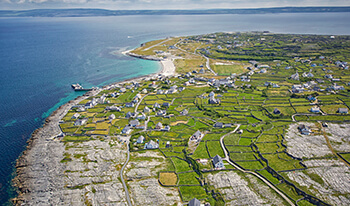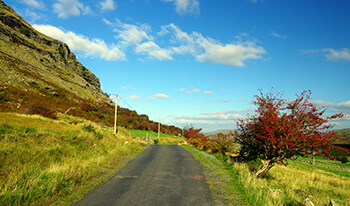The Céide Fields (Irish: Achaidh Chéide) is an area situated on the north Mayo coast in the west of Ireland. This location contains one of the oldest known field systems in the world. Using various dating methods, it was discovered that the creation and development of the Céide Fields goes back some five thousand years. This dates them before the building of the pyramids of Egypt and Stonehenge.
Visit the multi-award winning Centre, which has exhibitions, audio-visual show and tearooms and take a guided tour with our professional guides and discover a buried wall for yourself using a centuries old method of probing. Experience the unique ecology of the bogland, with it's colourful mosses, sedges, lichens, heathers, flowers and insect-eating sundews while listening to the larks. Find out the fascinating story of an ever-changing landscape, such as why bogs grow and the huge influence a subtle change in climate can bring about.
History The discovery of the Céide Fields originally began in the 1930s when a local man, schoolteacher Patrick Caulfield, noticed piles of stones which were uncovered as he cut away turf for fuel. In these piles he saw some design which could not have been haphazard. While this meant nothing to others, Caulfield noted that the stones had to have been placed by people, because their configuration was clearly unnatural and deliberate. Furthermore, they were positioned below the bog, which meant they were there before the bog developed, implying a very ancient origin.
The unravelling of the true significance of this discovery did not begin for another forty years when Patrick's son, Seamus, having studied Archaeology, began to investigate further. What was revealed in the ongoing investigations was a complex of fields, houses and megalithic tombs concealed by the growth of blanket bogs over the course of many centuries.
Research and preservation: In order to preserve the site and ensure the continuation of research, a simple method was utilised to explore the fields. This involved the location and mapping of these hidden walls by a specially developed simple and completely non-destructive method of probing with iron rod. The ensuing excavation of habitation sites and tombs is yielding a unique picture of the way of life of our ancestors 200 generations ago. We now know that they were a large, highly organised, peaceful community of farmers who worked together on clearing hundreds of acres of forestry and dividing the land into regular field systems[citation needed]. Their main economy was cattle rearing but they were skilled craftspeople and builders in both wood and stone and also had strong spiritual beliefs.
From data gathered it was discovered that these people arrived in a land with a substantial forest canopy. This was cleared to provide access to arable land and to provide building material and firewood. This clearance continued onward and outward away from the area in continuing procurement of firewood.
The climate at the time was much warmer, leading to almost year round growth potential. Samples taken from the remains of trees found in the bog provide ample evidence of this.
For a while, these people prospered, but some changes led to the development of raised bogs and the transformation of the arable land into barren and unusable land. It is speculated that the removal of the tree canopy helped cause this change. Where tree cover is substantial, most of the rain dropped on the land never reaches the ground. Instead it stays on the top of the canopy and is either absorbed or evaporates back into the atmosphere. With the removal of the forests, all of the rain reached the ground and, it is believed, bleached the earth of its nutrients. This idea is supported by the presence of a pan in the sub-soil over the area of the Céide Fields.
Tours featuring this attraction
Peace of Mind Guarantee
Your trip, worry free!Our Ireland based team is on call throughout your vacation!


